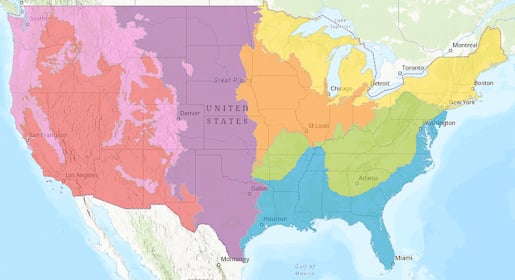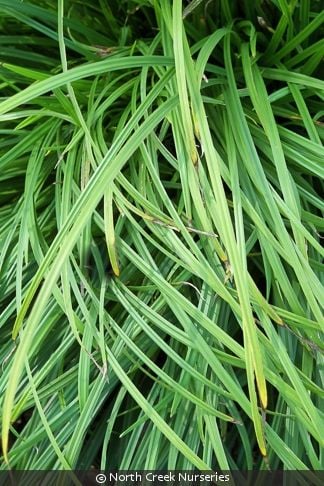
Carex amphibola eastern narrowleaf sedge
Characteristics
Descriptions
Also known as:
Light Requirements
Soil Moisture
Soil Description
Height
Recommended Spacing
Bloom Time
Hardiness Zone
Description
This adaptable, medium-bladed sedge is an excellent groundcover and a smart sub for Liriope. Carex amphibola is mostly evergreen in colder climates and fully evergreen in warmer ones. It’s a clumper that reseeds readily to provide dense coverage. As a habitat generalist, it’s one of the more wide-ranging sedges in the Eastern U.S. It's found in variable conditions--everything from flood plains to slopes above streams, to uplands.
Cultivation
The other common name for Carex amphibola, creek sedge, indicates its fondness for moist or wet soils. But this adaptable sedge can adjust to drier conditions and isn't picky about soils. Being evergreen to semi-evergreen, it’s slow to emerge from a full cutback, so selective removal of tattered foliage is best. It will reseed if happy, so only put where you'd like more or pluck out seedlings when they're young.
Recommended Spacing
Space plants 12"-24" apart.
As noted, eastern narrowleaf sedge will readily reseed, especially in favorable conditions. Spacing plants so they overlap will provide dense coverage, and expect some fill-in as seedlings pop up.
Companion Plants
Whether you call it creek sedge or eastern narrowleaf sedge, Carex amphibola plays well planted among other perennials. Species to try include Eupatorium perfoliatum (common boneset), Heliopsis helianthoides (smooth ox-eye), Helenium autumnale (common sneezeweed), Heuchera americana (alumroot), Scutellaria incana (hoary skullcap), and Zizia aurea (golden zizea).
Additional Notes
Carex amphibola is a larval food for some skipper butterflies, and its seeds are eaten by turtles.

Pricing & Availability
Maps, Wetland Status & More
MAP OF NATIVE RANGE
Recorded County Distribution: USDA data.
Native To
| AL, AR, CT, DC, DE, GA, IA, IL, IN, KS, KY, MA, MD, ME, MI, MN, MO, MS, NC, NE, NH, NJ, NY, OH, OK, PA, RI, SC, SD, TN, VA, VT, WI, WV, FL, LA, TX |
Legal Status
| Endangered | NJ, NY |
Wetland Status
| Atlantic and Gulf Coastal Plain | FACW |
| Eastern Mountains and Piedmont | FAC |
| Great Plains | OBL |
| Midwest | FAC |
| Northcentral and Northeast | FAC |
MAP OF WETLAND DELINEATION REGIONS

Interpreting Wetland Status
|
Code |
Status |
Designation |
Comment |
|
OBL |
Obligate Wetland |
Hydrophyte |
Almost always occur in wetlands |
|
FACW |
Facultative Wetland |
Hydrophyte |
Usually occur in wetlands, but may occur in non-wetlands |
|
FAC |
Facultative |
Hydrophyte |
Occur in wetlands and non-wetlands |
|
FACU |
Facultative Upland |
Nonhydrophyte |
Usually occur in non-wetlands, but may occur in wetlands |
|
UPL |
Obligate Upland |
Nonhydrophyte |
Almost never occur in wetlands |
Classification
| Kingdom | Plantae | Plants |
| Subkingdom | Tracheobionta | Vascular plants |
| Superdivision | Spermatophyta | Seed plants |
| Division | Magnoliophyta | Flowering plants |
| Class | Liliopsida | Monocotyledons |
| Subclass | Commelinidae | |
| Order | Cyperales | |
| Family | Cyperaceae | Sedge family |
| Genus | Carex | sedge |
| Species | Carex amphibola | eastern narrowleaf sedge |
ADDITIONAL COMMON NAMES:
creek sedge
SCIENTIFIC SYNONYMS:
Carex grisea var. amphibola
Plant Sizes
Sizes info
Shipping & Planting
SHIPPING INFO:
Shipping is free on all plants orders!
Your plants will ship using each grower’s preferred method: FedEx Ground, UPS Ground, or Spee-Dee Ground (in select midwestern states). Our growers ship orders Monday through Wednesday. The farther your plants need to travel, the earlier in the week they will ship. The goal is to have all plants delivered by the end of the week.
Shipping plugs:
Plugs are shipped in full flats, sometimes also referred to as trays. Multiple flats can be shipped in a single box. The flats are wrapped in netting or craft paper to secure the plants, and spacers are used between flats to keep the plants from being crushed.
When you unpack your plugs, the plants will have been somewhat flattened by the netting or craft paper. They will straighten out within a couple of days. You may also gently “fluff” them a bit to speed up the process. In some cases, your plants might have been cut back before packing, if the grower deemed them to have become too tall for safe packaging. Don’t worry, though, these guys know what they’re doing and would not compromise the health of the plants. They’ll fill back in in no time.
After receiving your plants’ journey in a dark box, it will be important to acclimate them to sunlight again. Over a couple of days, you should gradually move them into their preferred light exposure, and water them as per their requirement.
Although we always recommend putting your plants in the ground as soon as possible, they can stay healthy in the flats for a considerable amount of time. The key is to respect their growing requirements: if the species requires full sun, do not store them in the shade. If it is best adapted to dry soil, do not over-water.
PLANTING INFO:
Planting plugs:
We consider plugs ready to ship when the plants’ roots have filled the entire liner cell and the plants can easily be pulled out. In some cases you will have to go about it gently, wiggling the plant by the crown, and possibly squeezing the bottom of the liner to compress the growing medium and release the roots. Other times, the plants will appear to be root bound. They are not in the traditional sense. The plants are healthy but they have used up all the growing medium available to them. Plugs are at an aggressive stage of growth. As soon as planted the roots will immediately expand into your native soil. They establish faster than plants in larger containers, because they don’t have the luxury of a lot of growing media that can inhibit the roots from venturing outside of their comfort zone.
We are not going to address area preparation because the process can be complex and is always site-specific. However, as a rule, we recommend disturbing the soil as little as possible, and we do not recommend amending the soil. If you chose the right plant for the right conditions they will thrive. Any disturbance and amendments will only encourage weeds to emerge that never had a chance to do so before.
Installing plugs cannot be easier: dig a hole large enough for the roots to fit snugly inside, then water them in to eliminate air gaps. We recommend using a soil knife, sometimes referred to as hori hori, or a drill-adapted auger if it’s a large installation. If you use an auger, you will need a powerful drill. Depending on the size of the project and the type of soil, the process can be beyond what an average drill will bear. Mulching is recommended after installation to help keep weeds down while the plants establish. Be sure to keep it away from the crown of the plants. For large projects, you may want to mulch the area before planting, rather than tiptoeing through it after the fact. As a side note: if you are installing plugs in the fall, you might want to plant them so that the crown is about ¾” lower than the surrounding soil. The winter’s freeze/thaw cycles can push plugs out if the roots did not have enough time to establish and anchor them in.





